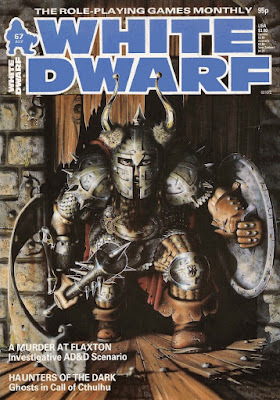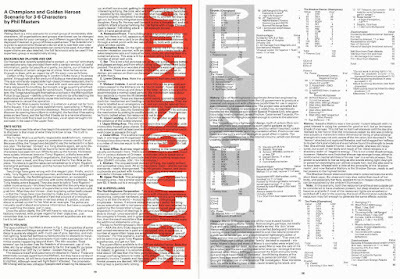White Dwarf: Issue #67
 Issue #67 of White Dwarf (July 1985) is one I remember very well, largely for a single article with which I became quite enamored after having read it at the time (more on that soon). Featuring a cover by Mark Bromley, this issue is also fixed in my memory because it was the last issue I received by subscription. I still continued to read the magazine for some time after this, but I never again had a subscription to it. Precisely why I ended my subscription I can't recall; it may have been simple laziness on my part.
Issue #67 of White Dwarf (July 1985) is one I remember very well, largely for a single article with which I became quite enamored after having read it at the time (more on that soon). Featuring a cover by Mark Bromley, this issue is also fixed in my memory because it was the last issue I received by subscription. I still continued to read the magazine for some time after this, but I never again had a subscription to it. Precisely why I ended my subscription I can't recall; it may have been simple laziness on my part. Ian Livingstone's editorial notes that, "after nearly ten years of running a poor second to the USA in the creation of fantasy games ... Britain is quickly catching up." Though intended as a boast – and a bit of self-promotional for Games Workshop's products – there's a great deal of truth in this. By the mid-1980s, the industry leader, TSR, felt like a spent force, even to a fanboy such as I. No other American company ever achieved the same level of success or reach until the '90s, leaving an opening for a new top dog. Warhammer, still on the rise at the time, would soon become the juggernaut it remains today.
The issue's articles begin with the cleverly named "Haunters of the Dark" by Graeme Davis. Over the course of three densely-packed pages, Davis offers up rules and ideas for handling ghosts in Call of Cthulhu. This is the article that made the issue for me in my youth, as I was much impressed not only with the content of the article itself but the possibilities it opened up. In my teen years, CoC was my go-to game for horror. While the game provided some support for non-Mythos adversaries, that was never the focus of the game. This article was a step toward correcting that and I adored it.
"Open Box" opens with a very fair but largely negative review of Pacesetter's Star Ace (5 out of 10), a science fiction game whose mix of ideas never managed to gel. Also reviewed is Monster Coliseum for the Avalon Hill edition of RuneQuest, which fares only slightly better (6 out of 10). Finally, there are reviews for three Dragonlance modules: Dragons of Flame (7 out of 10), Dragons of Hope (8 out of 10), and Dragons of Desolation (9 out of 10). In retrospect, it's quite fascinating to be reminded of just how well received Dragonlance was at the time. While the reviews here are not wholly without criticisms, the overall tone is positive. Though I remain convinced that, on balance, Dragonlance was a net negative for the development of D&D, there really was a hunger at the time for what the Hickman Revolution was offering.
Dave Langford's "Critical Mass" laments the pace at which fantasy and science fiction books are being published – and his own inability to keep pace with reviewing them. Consequently, he decides not even to try, focusing instead on longer reviews of fewer books than one lots of rapid fire bullet point reviews of everything that comes across his desk. Even so, Langford still manages to review slightly more than a half-dozen books in this month's column, which is nothing to sneeze at. The standout is his review of Brian Aldiss's Helliconia Summer, the final book in what Langford calls "an impressive trilogy." I couldn't agree more.
"Loam Wolves" by Barry Atkins is a fun little article that introduces "barbarian" magic to replace standard battle magic in RuneQuest. As its title suggests, the magic takes the form of runes drawn with moist earth upon the body of a barbarian, imbuing him with certain powers for a duration of time. While not mind-blowing by any means, it's a solid, flavorful article of the sort I generally like. "Peking Duck" by Phil Masters is a superhero brawl set in and around a Chinese restaurant, the Fo Yen Wok. Statted for both Champions and Golden Heroes, the article is also notable for the appearance of yet more terrible graphic design choices by the White Dwarf staff. Behold!
 "Worldly Wiles" by Anna Price discusses "social customs in Traveller." It's a fairly innocuous examination of how to flesh out the societies and cultures of new worlds by reference to history and science fiction literature – nothing special. "A Murder at Flaxton" by Michael Heaton, meanwhile, is much more interesting. It's a low-level AD&D scenario set in a seaside town beset by smugglers and slavers, filled with lots of hidden secrets and memorable NPCs. Though the situation presented in the scenario is far from innovative, Heaton handles it well. I think it could serve as an enjoyable kick-off of a new campaign.
"Worldly Wiles" by Anna Price discusses "social customs in Traveller." It's a fairly innocuous examination of how to flesh out the societies and cultures of new worlds by reference to history and science fiction literature – nothing special. "A Murder at Flaxton" by Michael Heaton, meanwhile, is much more interesting. It's a low-level AD&D scenario set in a seaside town beset by smugglers and slavers, filled with lots of hidden secrets and memorable NPCs. Though the situation presented in the scenario is far from innovative, Heaton handles it well. I think it could serve as an enjoyable kick-off of a new campaign."Parlour Game" by Stephen Dudley is a terrific article on a topic I loathe: spiders. The article provides lots of information about the hunting practices of spiders, as well as their use of webs to achieve similar goals. Obviously, not every referee will care about this sort of thing, but, in an adventure that heavily features eight-legged baddies, the additional detail might well be useful. "The Vivimancer" by Steve Palmer introduces a strange new "monster," a bodhisattva-like being returned to the land of the living after death to aid "goodly characters in their struggle against evil." The vivimancer is a powerful healer and foe of undead, demons, and devils. As presented, I suppose it'd be useful as an ally to the PCs rather than as a front-line combatant, which I don't mind (too much).
"The Magic Frame" by Joe Dever and Gary Chalk discusses the ins and outs of photographing miniatures. Specifically, the article talks about the best kinds of cameras and equipment for doing so, which is a topic I'd never really considered before. "Traveling Light" describes a collection of special magical and mundane backpacks, like messenger packs, which teleport items from one backpack to another to which it is connected. I appreciate minor magical items of this sort. The issue also includes further installments of "Thrud the Barbarian," "Gobbledigook," and "The Travellers," as usual. The last one is noteworthy this month, because it not only concludes a long-running storyline, it also does so by recourse to a random dice roll à la 76 Patrons.
As I said at the beginning of this post, this is an issue I remember well. The issues that follow are hazier in my memory, so it will be fascinating to re-read them. I wonder how much of their content will seem genuinely new to me and how much I'll begin to recall once I've had the chance to peruse them again.
James Maliszewski's Blog
- James Maliszewski's profile
- 3 followers



